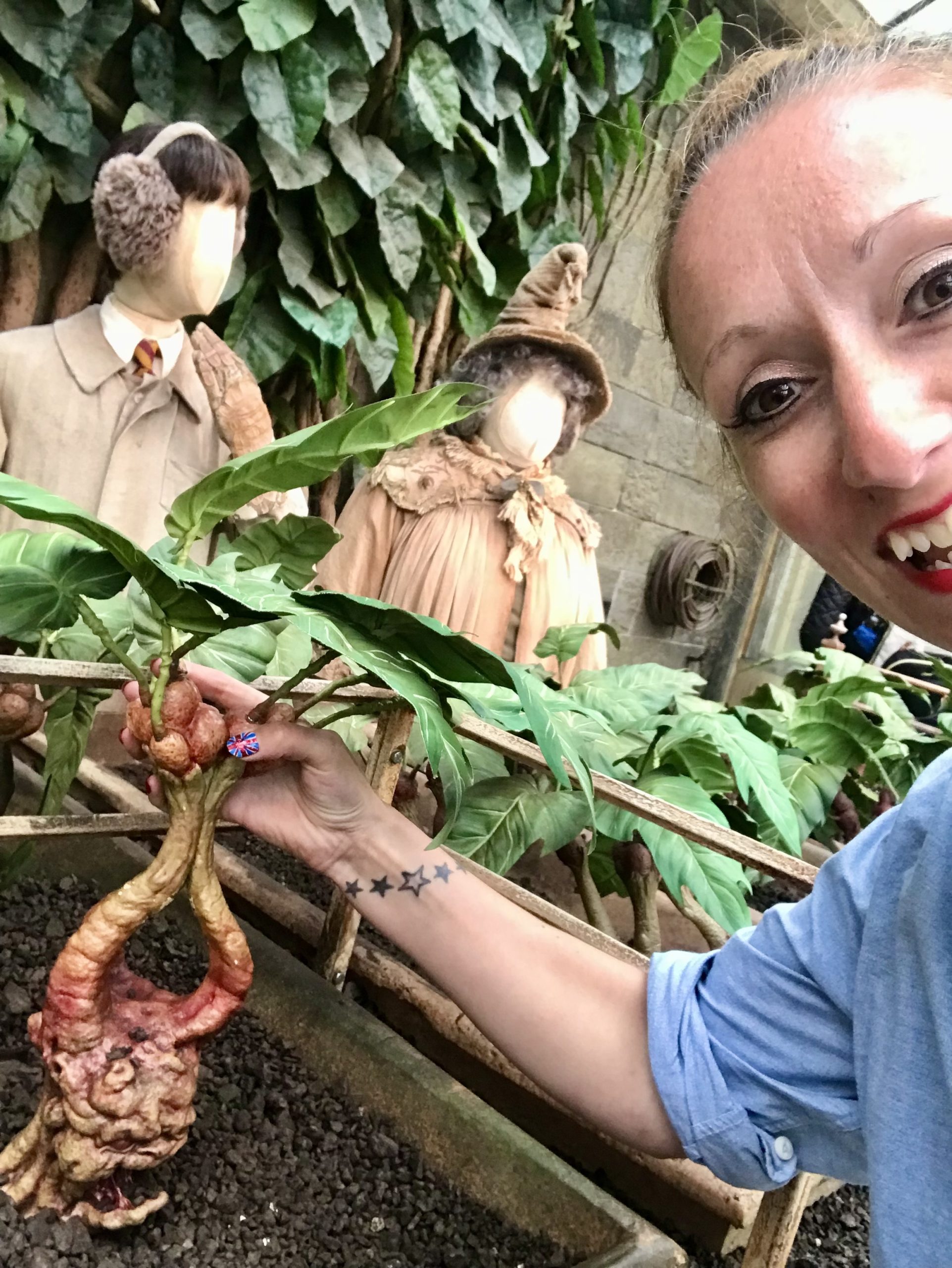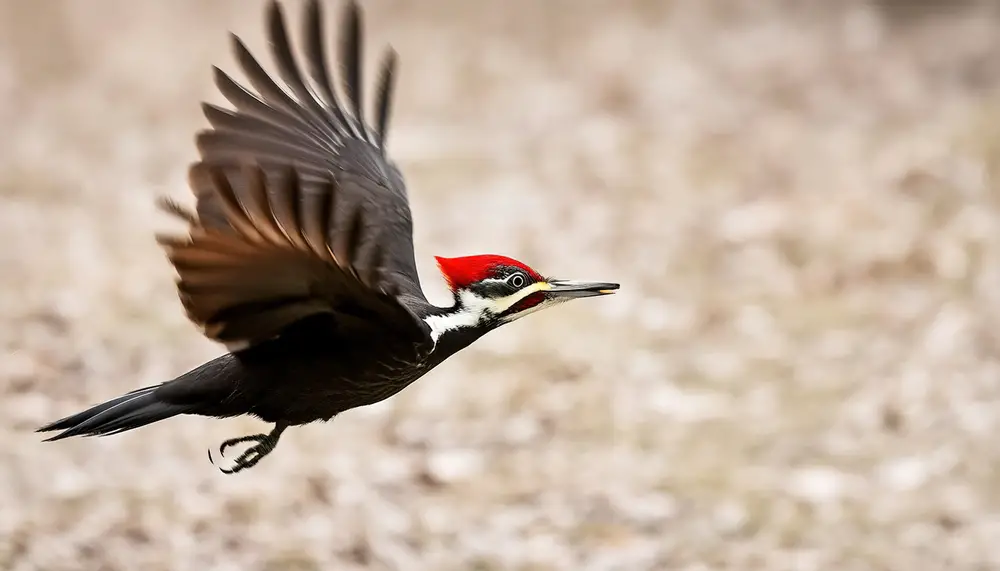Did you know the oldest Pileated Woodpecker lived until nearly 13 years old? There’s lots to learn about these fascinating birds!
There are around 390 species of Missouri birds, including seven types of woodpeckers. In fact, woodpeckers live all over the United States!
In this article, we’re going to dive into all the details and delve into some amazing woodpecker facts in Missouri.
So, read on for our comprehensive guide to woodpeckers in Missouri, covering their habitat, behavior, conservation, and tips on how to attract them.
Habitat and Distribution
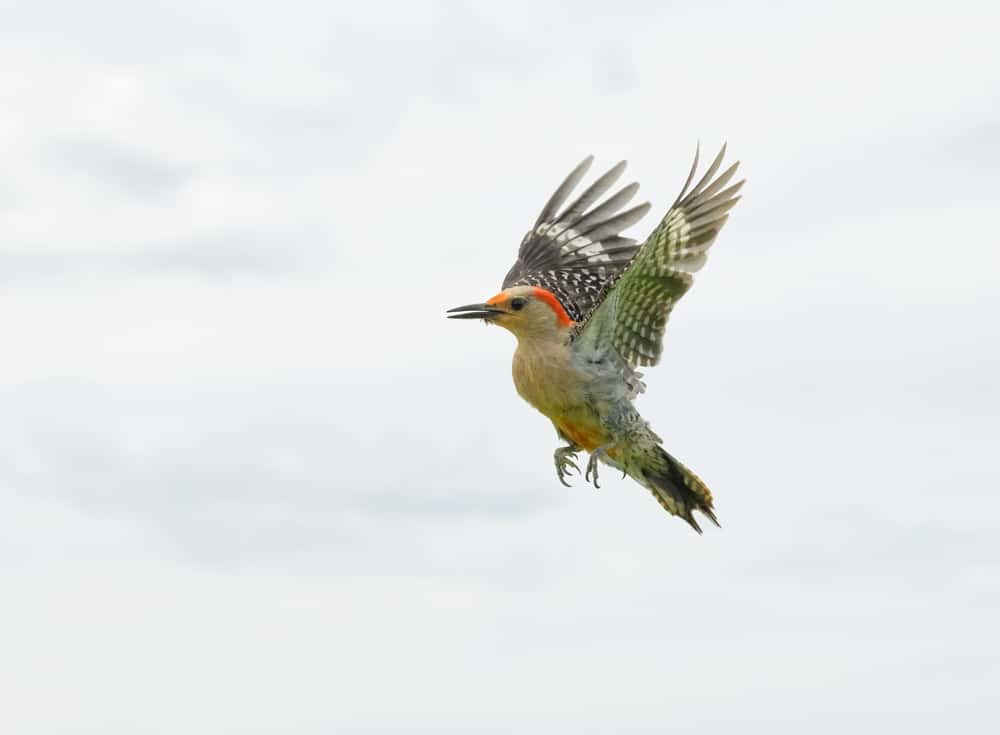
Missouri is home to a diverse range of woodpecker species, which can be found in various habitats throughout the state. It is an excellent state for observing these intriguing birds.
Woodpecker Habitat In Missouri
Missouri’s diverse landscapes provide suitable habitats for various woodpecker species.
Woodpeckers across Missouri thrive in diverse environments, including:
- Deciduous forests
- Mixed woodlands
- Riparian areas
- Orchards
- Urban parks with mature trees
Ideal habitats for these birds are those with a mix of live and dead trees. Such environments offer ample food sources and nesting sites, supporting their population.
Woodpecker Migration Patterns In Missouri
Woodpecker migration patterns in Missouri vary depending on the species.
Most woodpeckers in the state, such as the Downy, Hairy, Pileated, and Red-bellied Woodpecker, are year-round residents. This means they do not migrate and they remain in their Missouri habitats throughout the year.
Northern Flickers and Red-Headed Woodpeckers may migrate, moving to southern regions during the winter months and returning to Missouri in the spring to breed.
Migration patterns of the Red-Headed species are influenced by factors like food availability and weather conditions..
Where To Find Woodpeckers In Missouri
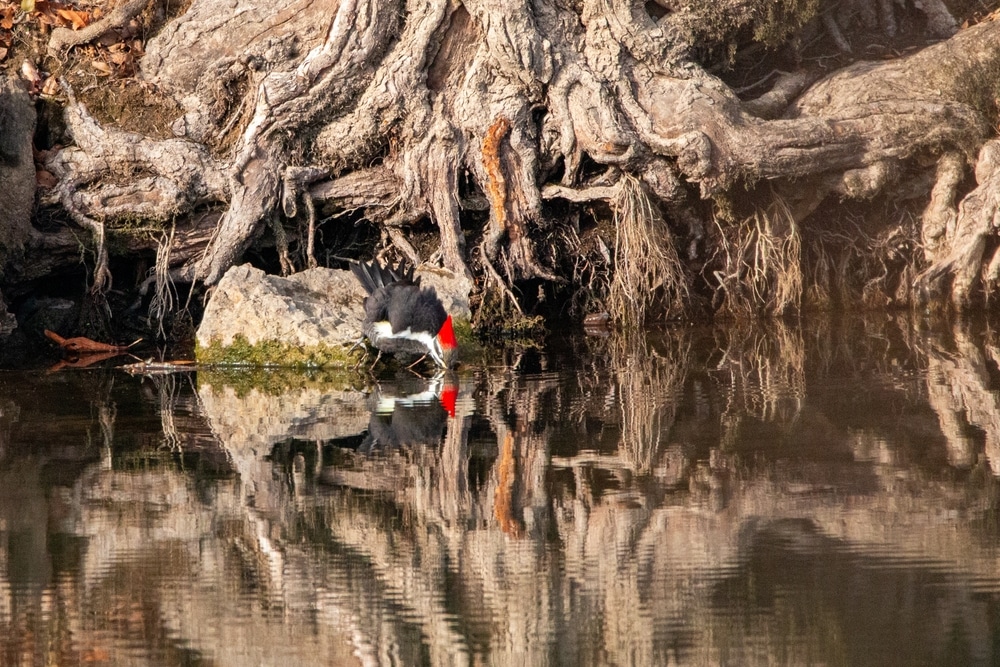
Missouri’s diverse habitats host a range of woodpecker species, making it a great place for observation..
Here are some places in Missouri where you can spot woodpeckers
- Ozark Mountains
- Mark Twain National Forest
- Wildcat Glades
- Roaring River State Park
- Big Oak Tree State Park
- Mingo National Wildlife Refuge
- Riverlands Migratory Bird Sanctuary
- Forest Park in St. Louis
- Schell-Osage Conservation Area
- Busch Conservation Area
Visiting areas like these will give you the best chance to observe these fascinating birds.
Woodpecker Behavior And Characteristics
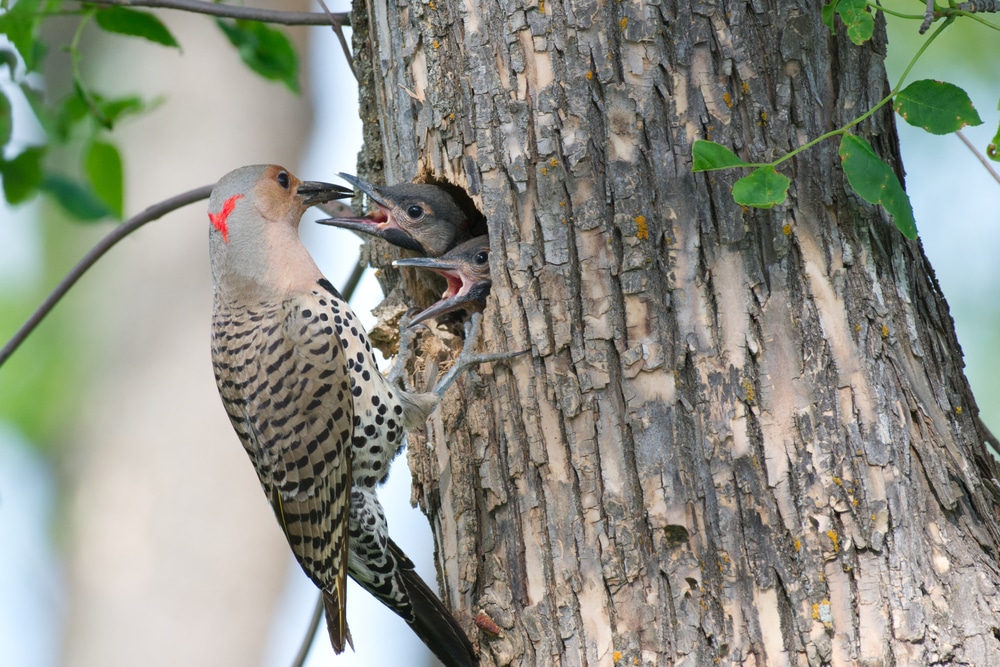
Woodpecker behavior and characteristics are fascinating! Their colorful plumage, strong beaks, and unique calls make them exciting birds to observe. Their characteristic drumming is used to establish territory, find food, and attract mates.
Missouri Woodpecker Mating: Courtship Rituals, Nest Building, and Breeding Season
Woodpecker mating involves fascinating behaviors and rituals that vary by species but generally include distinct courtship displays, meticulous nest building, and a specific breeding season.
Courtship Rituals: During the breeding season, male woodpeckers often perform elaborate courtship displays to attract a mate. These rituals include drumming on trees to produce resonant sounds, which serve as both a territorial signal and a way to showcase fitness. They will also use man-made objects (such as metal signs) to produce loud drumming noises. Some species also do in-flight displays and perform intricate postures to woo their mates.
Nest Building: Once the pair is established, the couple works together to build their nest. Their favorite real estate is in dead or dying trees. They can take weeks to create cavities by chiseling out wood with their strong beaks. The couple then line the nest with soft materials such as moss, woodchips, or leaves.
Breeding Season: Spring to early summer is the breeding season for these birds in Missouri. The females lay eggs in their prepared nests. They share parenting duties, taking turns incubating the eggs and feeding the chicks once they hatch.
Woodpecker Sounds and Communication
Next time you are out birding, you might hear the distinctive drumming woodpecker sounds in Missouri. These rhythmic drumming noises and their distinctive calls serve many different purposes, including:
- Searching for food
- Communicating with others
- Establishing territory
- Attracting mates
Woodpeckers use vocalizations and drumming for communication. In Missouri, their calls differ by species. For instance, the drumming of a Pileated Woodpecker resembles a pneumatic drill, while the Downy Woodpecker’s chatter is much quieter.
Diet Of Missouri Woodpeckers
Curious about what woodpeckers eat? Here’s a comprehensive look at their feeding habits!
Despite the colder weather, woodpeckers continue with their foraging activities. But as insect populations diminish in the winter months, you are more likely to see them at your feeders.
So, woodpecker diet vary by species and season, but in general, they like to eat:
- Insects and Larvae: The primary food source for most woodpeckers. They use their powerful beaks to peck into wood and bark to find beetles, ants, termites, and wood-boring larvae.
- Sap: Species like the Yellow-bellied Sapsucker are known for feeding on tree sap. They create small holes in trees with their beaks to access this sugary substance.
- Fruits and Nuts: You can often see a woodpecker foraging for fruits, berries, and nuts, particularly when insects are less abundant. Red-headed Woodpeckers, for instance, store nuts and seeds in tree crevices for later consumption.
- Seeds: In seasons when insects are scarce, woodpeckers turn to seeds as a supplementary food source.
- Suet: A favorite among woodpeckers, suet is a high-energy food that you can offer at feeders. They will be especially grateful for it during the colder months.
Woodpeckers in the Ecosystem
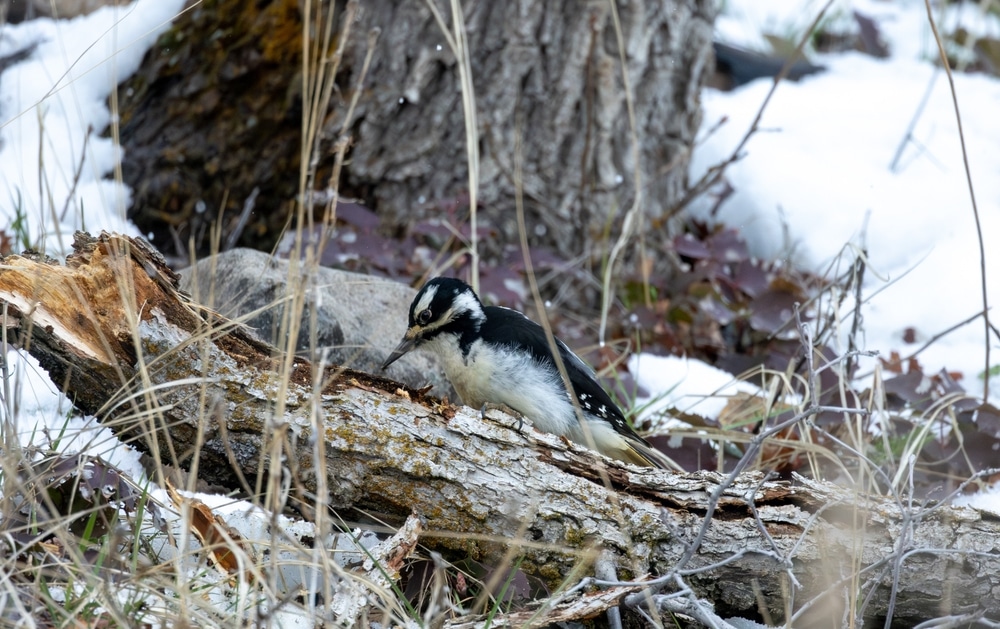
Missouri woodpeckers play a vital role in their ecosystem. Some of the benefits of woodpeckers include:
Woodpeckers are an excellent pest control species. They help control insect populations by feeding on beetles, ants, termites, and larvae. Their feasting on such creepy crawlies also helps save trees by reducing the damage the bugs make.
Did you know they build homes for others? Woodpeckers’ nesting cavities provide essential homes for various other species, including owls, bats, and small mammals.
Woodpeckers play a crucial role in maintaining biodiversity and forest health. By foraging for insects and creating cavities, they assist with nutrient cycling and tree decay, leading to healthier habitats.
Woodpecker Conservation
There are many challenges faced by Missouri’s woodpeckers, including:
- Loss of habitat
- Extensive logging
- Climate change
- More urban environments
- Vehicle mortality
The magnificent Ivory-Billed Woodpecker once lived in Missouri but unregulated practices meant they have been logged into extirpation. Extirpation means no longer living in a certain place whereas extinction means no longer living anywhere. In other words, extinction means the species has been wiped out. Some Ivory-Billed Woodpeckers have been spotted in Florida and Arkansas, but the species is at extreme risk in America.
The Red-Cockaded Woodpecker is another species that has been extirpated from Missouri. This is due to extensive logging, fire suppression, and people moving into forested areas. The Red-headed Woodpecker is currently listed as “Near Threatened.” Effective conservation efforts are crucial to ensure this species remains stable and continues to thrive.
Woodpecker conservation efforts in Missouri involve:
- Protecting habitat
- Leaving dead and decaying trees for woodpecker habitat
- Reducing pesticide use
- Supporting research
- Public Education
How To Attract Woodpeckers To Your Yard In Missouri

You can attract these wonderful birds to your yard by providing woodpecker-friendly habitat, native trees, and bird feeders and suet. This will help to keep woodpecker populations thriving, help biodiversity, and support your local ecosystem.
Provide Feeders
Use specialized feeders that hold seeds or suet to attract these birds. Suet is an excellent high-energy food source, particularly beneficial during winter months
Some species, such as the Downy Woodpecker, have also been known to visit hummingbird feeders!
Native Plants
Planting native trees and shrubs that produce berries and seeds, is a perfect way to include woodpecker-friendly plants into your backyard.
Offering natural food sources is one of the best ways to entice these intriguing birds.
Stop Tidying Your Yard!
Dead and decaying trees are essential to woodpecker habitat. They provide important foraging and nesting sites.
If it’s safe to do so, leave any big logs on the ground. Various beetles and insects will take up residence and provide food for woodpeckers.
So don’t be too quick to clean up!
Woodpecker Watching Tips

Here are some woodpecker spotting tips to help you with woodpecker sightings in Missouri.
Location: Go to wooded areas, forests, and parks where these birds are commonly found.
Timing: Woodpeckers are active in the early mornings and late afternoons. So schedule your birding around these times.
Sounds: Listen out for drumming sounds. This will help you to locate them.
Signs: Holes in trees or wood chips beneath trees are good signs that woodpeckers are about!
Flight: Keep your eyes peeled for that distinctive wave-like flight. Woodpeckers’ undulating flight pattern makes them easy to spot.
Viewing: Bring binoculars so you can get a close-up and identify the species. Don’t forget your camera to get some shots of striking colors and patterns.
Take Your Time: Patience is key with any birdwatching. Woodpeckers are sometimes elusive and require quiet observation. They are worth the wait!
Guides & Apps: Use local field guides or birding apps for species identification in Missouri. They are helpful for recognizing different woodpeckers and understanding their habits and calls. I never do any birding without my trusty Merlin Bird ID App!
Bird Safety: Never disturb birds, their nesting sites, or their young.
Birding Etiquette: Always respect other birders and wildlife.
Missouri Woodpecker Species
Here’s all the details on the seven types of woodpeckers found across Missouri:
Pileated Woodpeckers
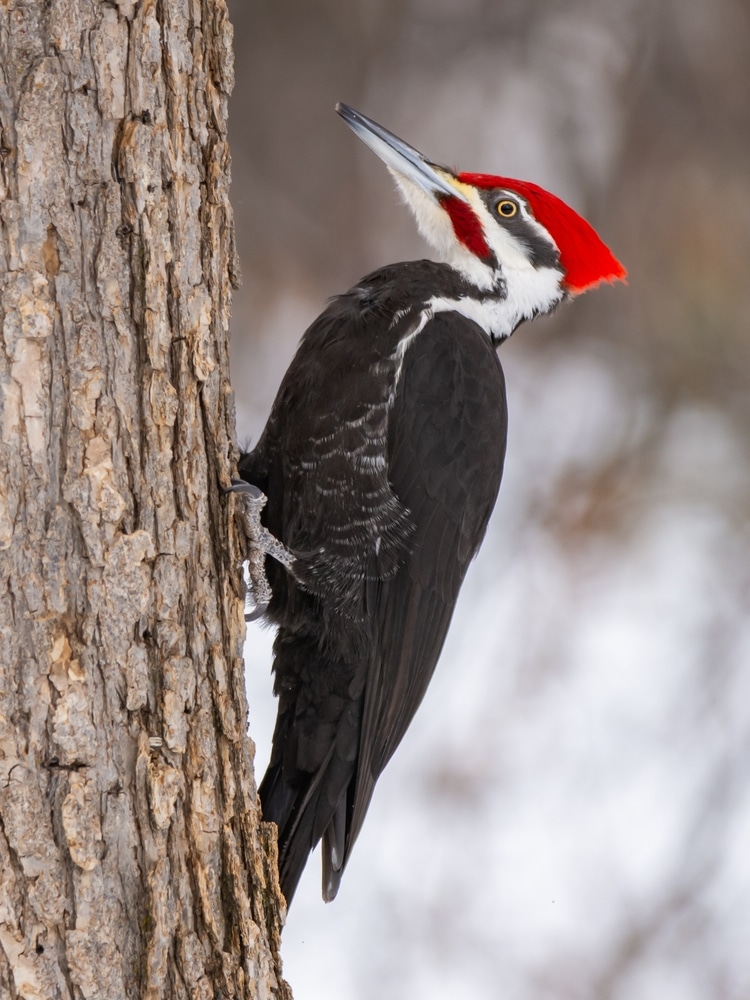
| Name | Dryocopus pileatus |
| Height | 15.8-19.3 inches (40-49 centimeters) |
| Wingspan | 26-29.5 inches (66-75 centimeters) |
The Pileated Woodpecker size is the largest woodpecker species in the region, boasting an impressive wingspan of 26 to 29.5 inches (66 to 75 centimeters). It has a distinctive appearance, including a nearly prehistoric look, black feathers with white face stripes, and striking white patches on the underwings. Its bright-red crest sweeps back on its head, adding to its dramatic appearance. The Pileated Woodpecker is hard to miss when it flies by!
The Pileated Woodpecker sound is loud! Their loud calls and pronounced drumming sounds certainly match their statuesque size.
Pileated Woodpeckers are often identified by the large rectangular holes they create in trees while foraging, so make sure to look out for these.
Their diet mainly consists of carpenter ants but also includes wood-boring insects, other ants, berries, fruit, and suet. To attract these majestic birds to your backyard, consider placing a suet feeder out for them to visit.
Downy Woodpeckers
| Name | Picoides pubescens |
| Height | 5.5-6.7 inches (14-17 centimeters) |
| Wingspan | 9.8-11.8 inches (25-30 centimeters) |

The Downy Woodpecker is the smallest species in the region. These tiny birds display a black-and-white coloration, with a distinct white stripe down their backs and white spots on their black wings. Males are further distinguished by a red patch on the back of their heads.
They enjoy feeding on insects, fruit, seeds, and suet, You are very likely to see them as frequent visitors to backyard feeders.
Hairy Woodpeckers
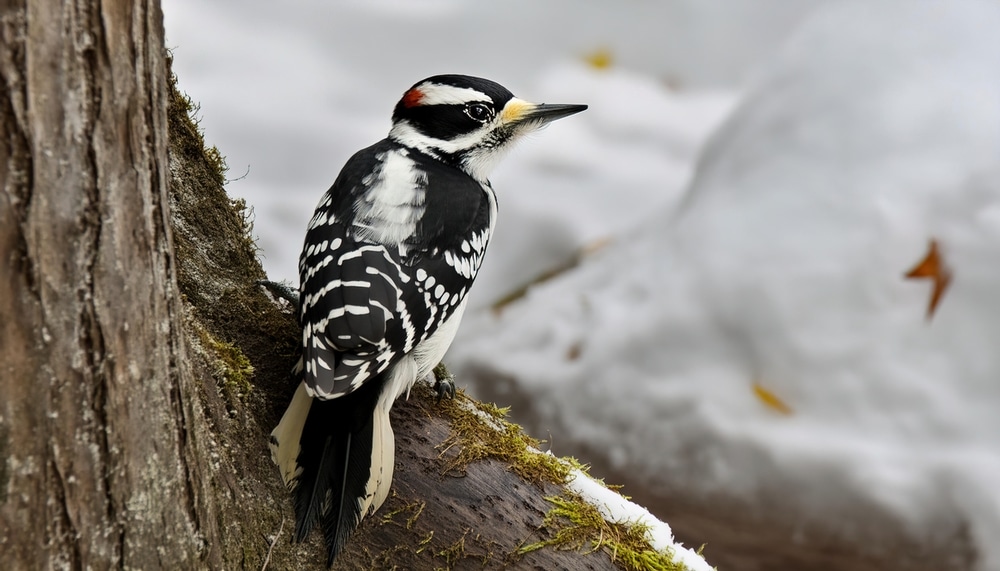
| Name | Picoides villosus |
| Height | 7.1-10.2 inches (18-26 centimeters) |
| Wingspan | 13-16.1 inches (33-41 centimeters) |
Hairy Woodpeckers are often confused with the smaller Downy Woodpeckers, as they look so similar. The best way to distinguish between the two species is by the length of their bills:
- Downy: Short chisel-like bill
- Hairy: Bill is equal in length to its head
Almost identical to the Downy, Hairy Woodpeckers are black and white, with two white stripes on their faces. Males feature red at the nape of their neck.
Hairy Woodpeckers will also visit your feeders. They like to eat fruit and seeds, as well as insects.
Red-Headed Woodpeckers (species of concern)
| Name | Melanerpes erythrocephalus |
| Height | 7.5-9.1 inches (19-23 centimeters) |
| Wingspan | 16.5 inches (42 centimeters) |
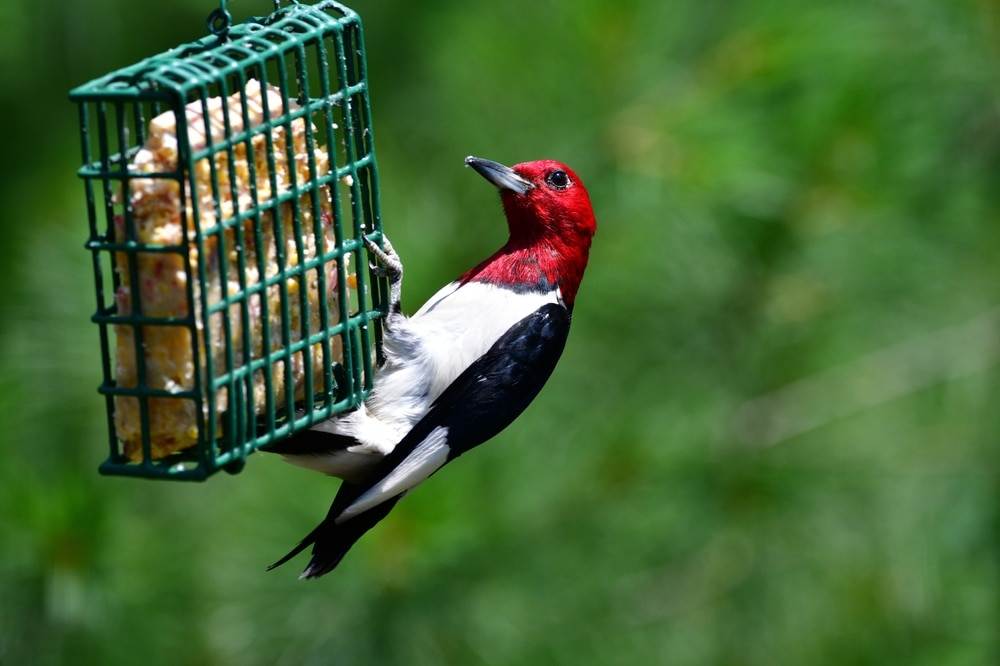
There is no mistaking a Red-Headed Woodpecker! Sometimes referred to as a checker-board, they have half-white and half-black wings, a white body and a completely bright red head.
Red-headed woodpeckers are unique hunters and catch insects mid-air! So look out for their aerial acrobatics!
Like other woodpecker species, Red-headed woodpeckers are omnivores. They eat insects, nuts, seeds, and fruit.
They also squirrel away seeds and nuts in tree crevices and return to them when other food is scarce!
Red-Bellied Woodpeckers
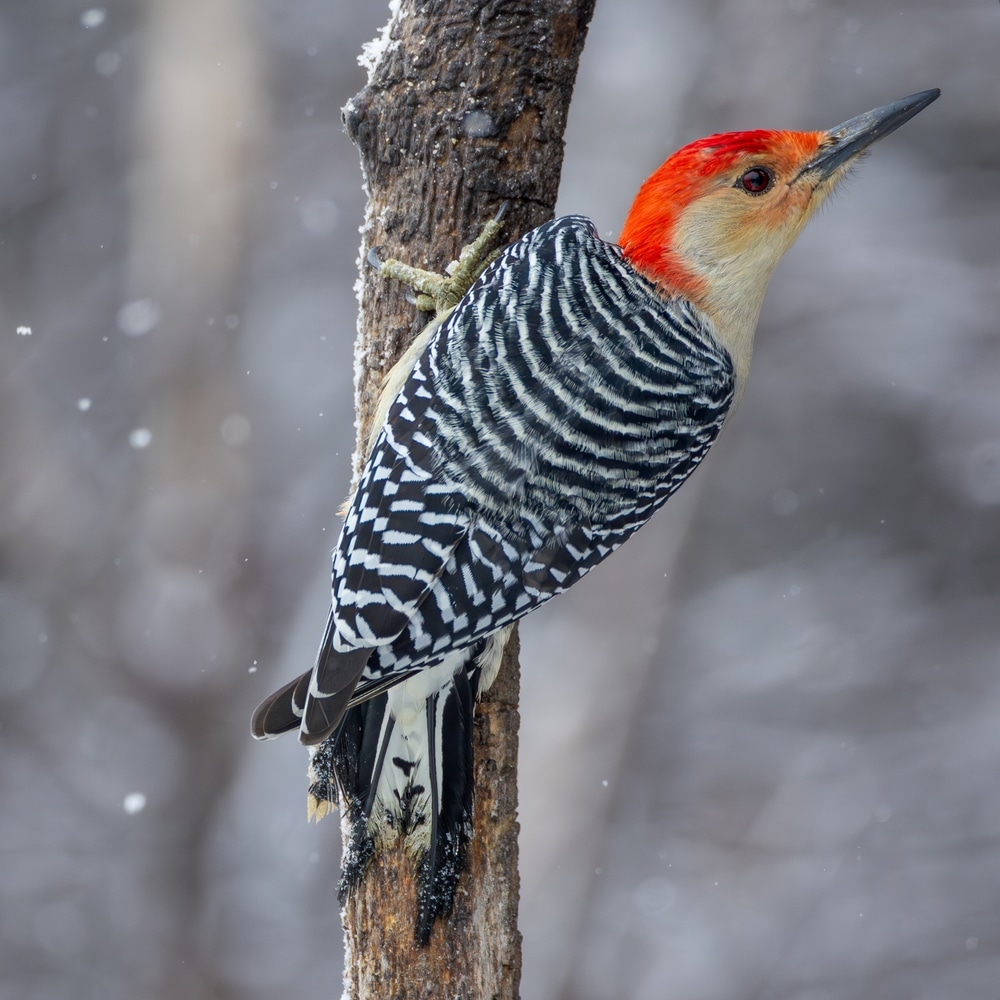
| Name | Melanerpes carolinus |
| Height | 9.4 inches (24 centimeters) |
| Wingspan | 13-16.5 inches (33-42 centimeters) |
Red-bellied woodpeckers have extremely long tongues! They can stick them out 2 inches from the end of their beaks!
These beautiful birds have black and white barred wings, a bright red head and nape of neck, and a light-colored body.
Red-bellied Woodpeckers feast on insects, suet, seeds, fruit, and nuts.
Unfortunately, nearly half of Red-bellied woodpeckers’ nests are taken over by Starlings.
Yellow-bellied Sapsucker
| Name | Sphyrapicus varius |
| Height | 7.1-8.7 inches (18-22 centimeters) |
| Wingspan | 13.4-15.8 inches (34-40 centimeters) |
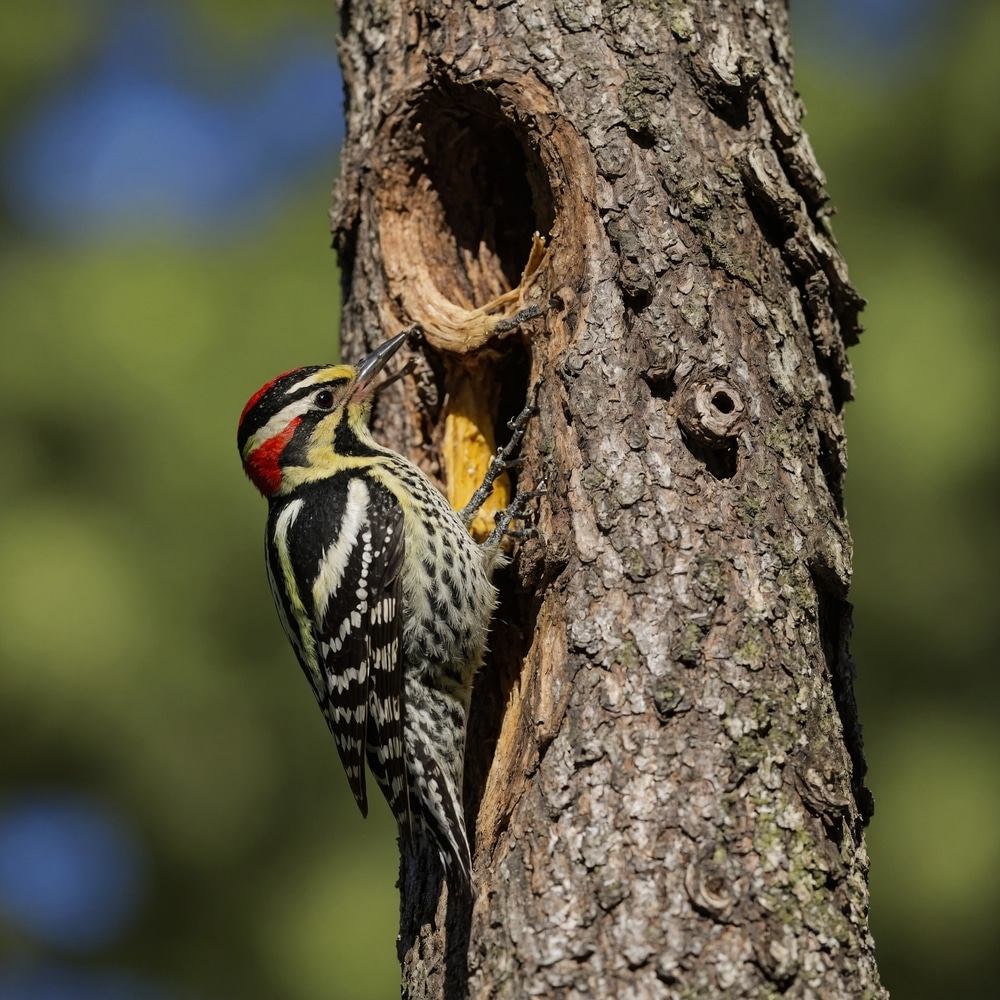
Even though they are called yellow-bellied, yellow is not their most striking feature! Sometimes their bellies are white or pale yellow! They are black and white, with strong black and white stripes on their faces. They have bright red foreheads and males have a red throat.
Interestingly, hummingbirds, other birds and animals will use the holes (sapwells) that Yellow-bellied sapsuckers make to feed off the tree’s sap! Yellow-bellied sapsuckers are a great addition to any ecosystem
Northern Flickers
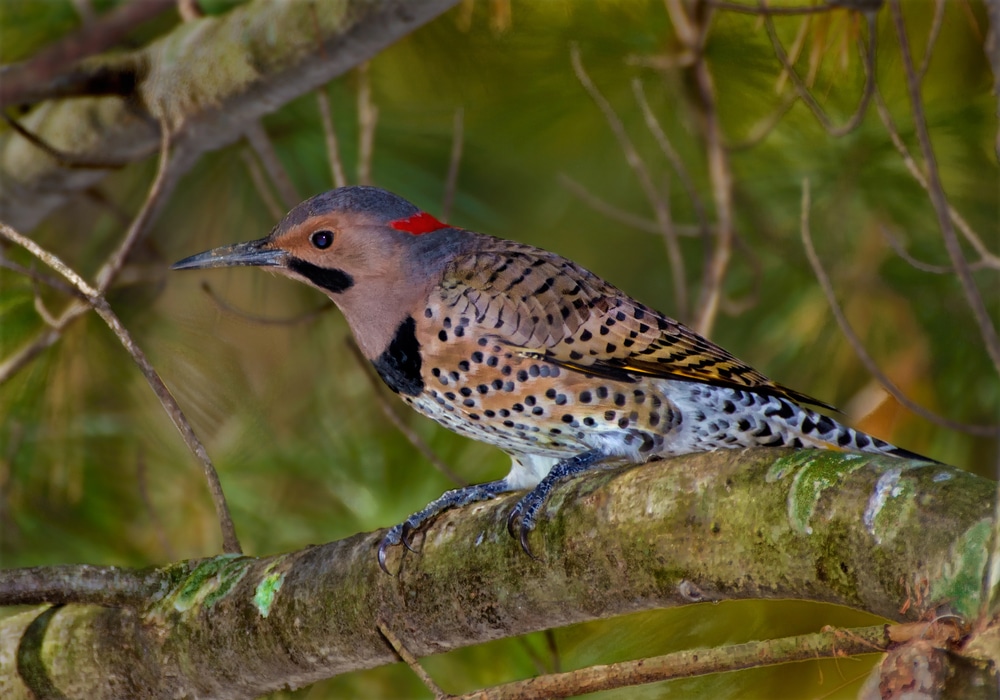
| Name | Colaptes auratus |
| Height | 11-12.2 inches (28-31 centimeters) |
| Wingspan | 16.5-20.1 inches (42-51 centimeters) |
Once you know a Northern Flicker’s call, you’ll be able to hear them a mile off! They use their drumming for communication, mating, and territory. These are noisy birds!
But they are also beautiful! They have a distinct black crescent on their chests, black-scalloped barring, and are pale overall. The underneath of their wings flashes either yellow or red, depending on their type.
- Yellow-shafted flickers are seen more in the East
- Red-shafted flickers are seen more in the West
Unlike other woodpeckers, Northern Flickers are often found on the ground foraging for ants and beetles. So watch out for them when you are walking through leaves!
